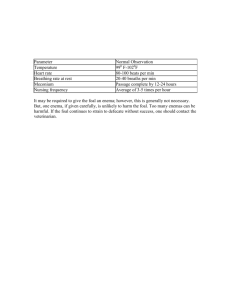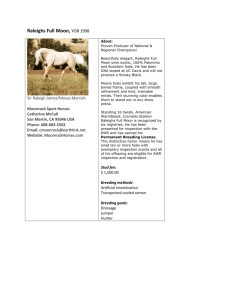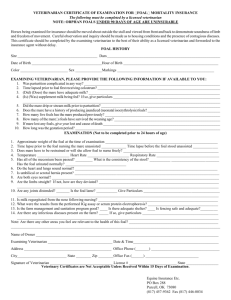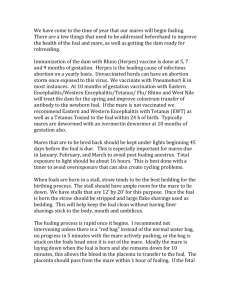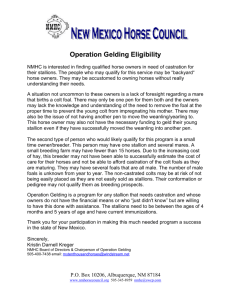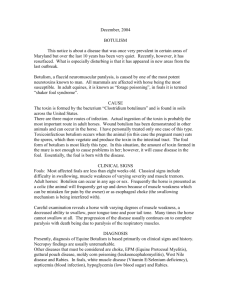Diseases of Foals SOME of the diseases that may attack a newborn
advertisement
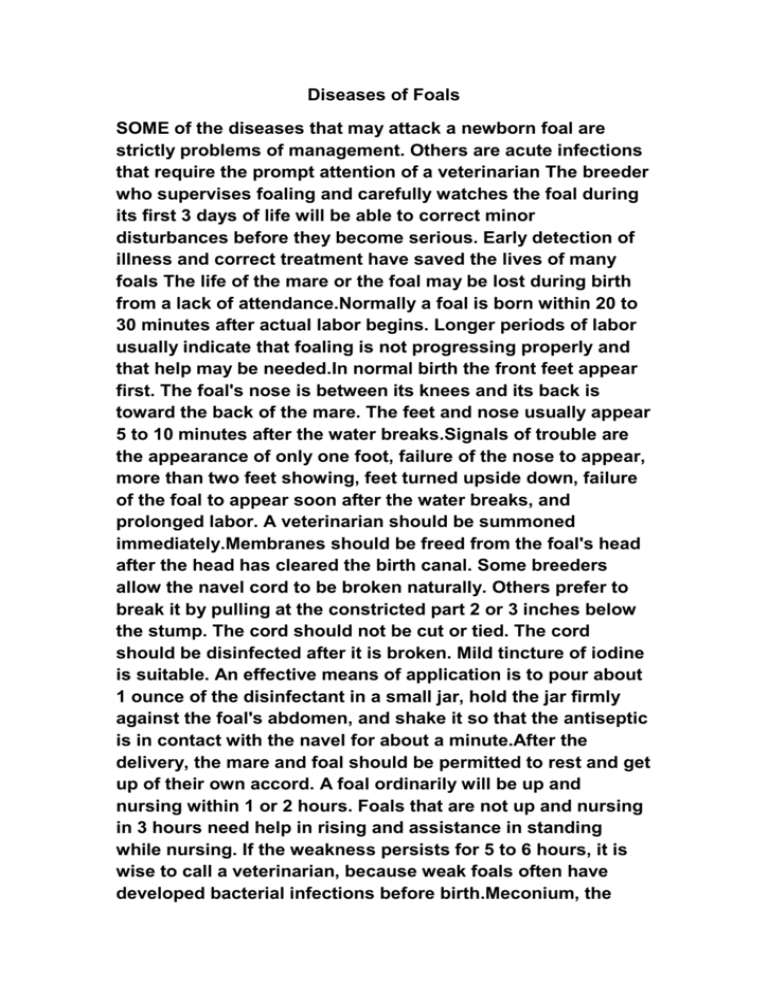
Diseases of Foals SOME of the diseases that may attack a newborn foal are strictly problems of management. Others are acute infections that require the prompt attention of a veterinarian The breeder who supervises foaling and carefully watches the foal during its first 3 days of life will be able to correct minor disturbances before they become serious. Early detection of illness and correct treatment have saved the lives of many foals The life of the mare or the foal may be lost during birth from a lack of attendance.Normally a foal is born within 20 to 30 minutes after actual labor begins. Longer periods of labor usually indicate that foaling is not progressing properly and that help may be needed.In normal birth the front feet appear first. The foal's nose is between its knees and its back is toward the back of the mare. The feet and nose usually appear 5 to 10 minutes after the water breaks.Signals of trouble are the appearance of only one foot, failure of the nose to appear, more than two feet showing, feet turned upside down, failure of the foal to appear soon after the water breaks, and prolonged labor. A veterinarian should be summoned immediately.Membranes should be freed from the foal's head after the head has cleared the birth canal. Some breeders allow the navel cord to be broken naturally. Others prefer to break it by pulling at the constricted part 2 or 3 inches below the stump. The cord should not be cut or tied. The cord should be disinfected after it is broken. Mild tincture of iodine is suitable. An effective means of application is to pour about 1 ounce of the disinfectant in a small jar, hold the jar firmly against the foal's abdomen, and shake it so that the antiseptic is in contact with the navel for about a minute.After the delivery, the mare and foal should be permitted to rest and get up of their own accord. A foal ordinarily will be up and nursing within 1 or 2 hours. Foals that are not up and nursing in 3 hours need help in rising and assistance in standing while nursing. If the weakness persists for 5 to 6 hours, it is wise to call a veterinarian, because weak foals often have developed bacterial infections before birth.Meconium, the fetal feces, may be impacted in the bowels, and an enema is required to remove it. Enemas are not necessary for every foal. Normally the foal begins to pass the meconium in a few hours. Retention of the meconium is indicated when the foal carries its tail high, strains frequently without bowel movement, and has colicky symptoms.Enemas, warm water or 2 ounces of glycerin in 1 quart of water, should be given with a small, soft rubber tube,which is inserted 10 to 14 inches into the rectum. No more than 1 quart of enema fluid should be used. Excessive or too frequent enemas may cause a diarrhea. Syringes with metal or hard rubber barrels should not be used, because they may puncture the wall of the rectum. If the impaction of the meconium is persistent, professional assistance should be called in.A CONDITION known as 9-day scours often causes worry among inexperienced horsemen. Foals often develop a diarrhea some 8 to 12 days after birth. Usually it is mild and persists for only a few days. The cause is thought to be a change in the milk that occurs in association with the mare's ninth-day heat period.Rupture of the urinary bladder is infrequent in young foals. The cause is not known. The rupture nearly always is lengthwise and on the upper surface of the bladder. The foal cannot urinate. All urine is deposited in the abdominal cavity. The affected foal becomes sluggish. The abdomen is distended by the accumulation of urine. Death occurs in 3 to 5 days. Most foals recover after the abdomen is drained and the urinary bladder is closed by surgery. CONTRACTED TENDONS, crooked legs, and aberrations of the feet are frequent in young foals. Any of these conditions may persist or become worse and affect the future soundness of the horse. Treatment consists of surgery on the affected tendons, use of braces, and corrective trimming of the feet.BACTERIAL INFECTIONS cause various diseases of foals, among them navel-ill, joint-ill (or arthritis), pneumonia, scours, generalized infections (or septicemia), tetanus, and wound infections.The micro-organisms involved most frequently are Shigella equirulis and streptococci. Organisms found less often are Salmonella abortus-equi, Corynebacterium equi, staphylococci, Escherichia colt, and Salmonella typhi-murium. Almost any one of the organisms can produce one or more of the symptoms associated with bacterial infections of young foals.Shigella equirulis infection is the most important single cause of illness and death of newborn foals. The organism exists in the digestive tract of horses. Infection may occur before or after birth. Symptoms frequently appear 1 to 3 days after birth. Then the disease is generalized and has little tendency to localize in joints or organs. The onset is rapid.Symptoms are an early rise of temperature, increased pulse and respirations, congested membranes, slightly swollen joints, dullness, weakness, rapid prostration, and early death. In foals more than a week old, the course of the disease is slower, and visible joint involvement is frequent. In foals less than 3 days old, lesions of an acute generalized infection, inflammation of the intestines, and a slight excess of joint fluid are the only postmortem findings. The kidneys in older foals usually contain many small abscesses, which usually are specifically diagnostic for the disease.STREPTOCOCCI are second only to Shigella equirulis as a cause of illness and death of foals. Infection often is present when a foal is born, but pronounced symptoms may not appear for a week or longer.Infection also is acquired after birth. Prenatal infection often results in abortion or death of the foal within a few days after birth. Foals dying during the first few days usually have generalized infection or pneumonia and the joints are involved slightly. In foals a week or more old, joint troubles are more frequent and more severe, and the course of the disease is slower. Symptoms are similar to those associated with S. equirulis infections, but the course of the disease is slower. Foals sometimes live 2 or 3 weeks before dying.Streptococci frequently are found in abscessed navels and are the commonest cause of infection in wounds or injuries of young foals.Staphylococci usually are found in infected wounds or with streptococci in respiratory infections.Tetanus, or lockjaw, is associated with infected navels or puncture wounds. Use of 3,000 units of antitoxin following puncture wounds and proper care of wounds will prevent tetanus. Annual immunization of pregnant mares with tetanus toxoid should provide passive colostrum antibody protection for the foal for a month or longer after birth.Escherichia colt infections cause acute septicemia. Symptoms are nervous disturbance and rapid prostration. The mortality rate is high. Death usually occurs in 1 to 4 days. Peritonitis and enteritis are frequent lesions. Occasionally the joints are involved. Many affected foals are weak or ill at birth an indication of prenatal infection.Corynebacterium equi usually affects foals 1 month old or older and causes pneumonia and abscesses of the lungs. The infection may spread and cause abscesses in the lymph nodes and other internal organs. Treatment usually is unsatisfactory. Salmonella typhi-murium infections are sporadic. Foals may be affected over a wide range of age. Symptoms are high fever, profuse diarrhea, and rapid dehydration and prostration. Lesions are those of acute generalized infection and inflammation of the intestines.THE CONTROL of infectious diseases of newborn foals begins with hygiene and correct selection before the mares are bred. Infection of the genital tract may be present before breeding, or introduced when the mare is bred, or acquired later. Mares with genital infections fail to become pregnant, abort, or produce a weak or dead foal.
